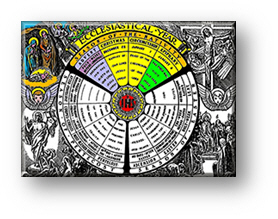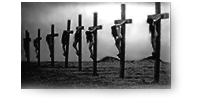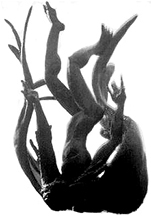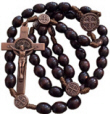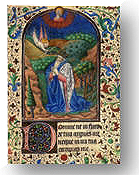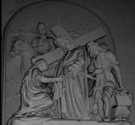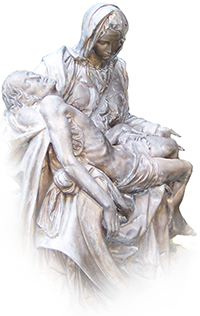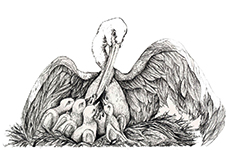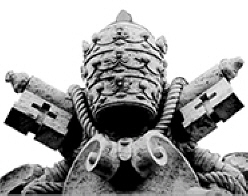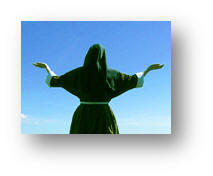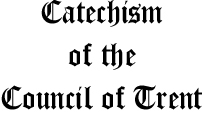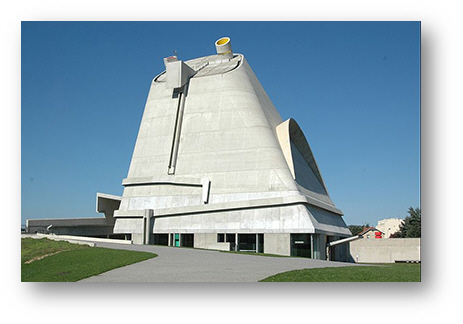|
|
|||||
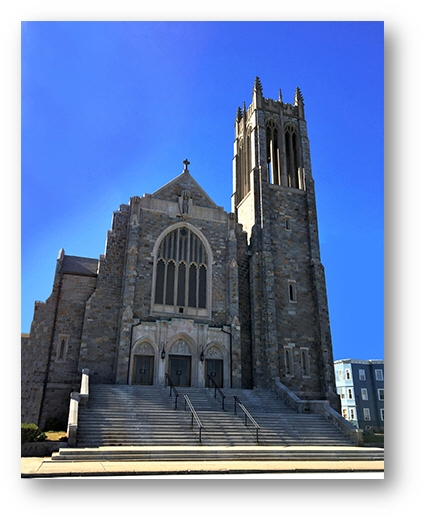 |
|
|
and Recognize No More: |
|
“The
city of thy sanctuary is become a desert; Sion
is made a desert, Jerusalem is desolate.
The house of our holiness, and of our glory,
where our fathers praised thee, is burnt with
fire,
and all our lovely things are turned into
ruins.” (Isaiah 64.10-11)
Let us remember what we have become — through what we have lost ...
— in so many ways “Jersulaem desolata est:” Jerusalem has become desolate — a wasteland of our narcissism, for we have made the City of God the City of Man, worshipping no longer the One True God in Whose image we are made, but the mere image itself for which we now clamor, calling it our god — and we are that image and now we have made ourselves that god.
Let us be called
away from ourselves ... to Almighty God; from our own delicate frivolities
to the hard work of sanctification and salvation. Let us rebuild Jerusalem,
for Her walls were pulled down from within, and it has collapsed
upon the children She once nourished — and in the ruins over which we
rejoice we still hear the plaintive cries of Her children beneath the
detritus:
“Iersulaem
desolata est!”
The Church is become desolate, a place of ruin, and Her children
have fled, recognizing Her no longer.
The 2000-Year-Old Catholic Church that We have Lost,
once
had:
-
Mortal Sin
-
Venial Sin
-
Saturday Confession for 2 hours, not 1/2 hour or, increasingly, “by appointment”.
-
No “altar servers” (now largely girls in unisex and quasi-monastic “habits”)
-
No invitation to applaud the choir, the soloist, the altar “servers”, the ushers, the lectors, etc., etc. at the end of Mass and before the final blessing.
-
Altar Rails
-
Women wearing chapel veils, or mantillas (white or black lace coverings for their heads), or some form of head covering, and were modestly dressed. No bare shoulders, plunging neck-lines, jeans, sports suits, or skirts above the knees.
-
All Readings read by the priest
-
All Communions were given by a priest
-
An Altar that was an Altar of Sacrifice and not a “Table”
-
The Mass understood, above all else, as a Sacrifice, not a communal (and often “fast-food”) feast
-
The Liturgy in Latin even while the readings were also in English
-
Was never called a “Faith Community” — it was called a “Church”
-
No such oddities called “Prayer Spaces” and “Worship Spaces”. We prayed “in Church”
-
No disposable monthly Missalettes
-
The “Saint Joseph Daily Missal” for Mass, it was leather-bound, and everyone had one
-
The Organ as the only musical instrument. The piano was unheard of outside the local school band or in the next town's “lounge”.
-
Rogation Days
-
Ember Days
-
Ferias
-
No guitars, drums, cymbals, flutes, or tambourines — and consequently no troupe of entertainers for whom it was mandatory to applaud at the end of Mass.
-
The organ and the choir unobtrusively in a loft at the back of the Church
-
A very clear understanding of Baptism as the washing away of Original Sin and a minor exorcism; it was a Baptism into the death of Christ, and an emergence into utter innocence free from sin
-
Priests who wore Roman cassocks
-
Sisters who wore full habits and always lived in community — not their own individual apartments
-
Nuns who wore full-length habits that swirled in the wind
-
No priest ever dressed in casual clothing — at any time
-
No one but a priest or deacon-soon-to-be-priest who ever approached or touched the Tabernacle
-
Absolutely no talking in the pews — only a sacred silence
-
Our Lady’s Sodality for women
-
The Tabernacle at the center of the Altar — not shunted off to the side and hidden as an embarrassing artifact of a long past Age of Faith
-
The Altar oriented to worshipping God — not “celebrating” the people
-
Convents (and they were full)
-
A Pastor who exercised complete authority and confidently led the flock entrusted to him; not a contentious parish council of largely liberal laywomen and disaffected laymen who “advised” the priest
-
Intelligibility throughout the world: you understood every part of the Mass, even if you did not understand Latin
-
Absolution in Confession with an unalterable (rather than an ad-libbed) and deeply spiritual formula*
-
No “Ministries” and thus no “Ministers.” Protestants had ministers. Catholics had priests
-
Kneeling for Holy Communion
-
Kneelers
-
An utter reverence for the Sacred Body of Christ: it was unthinkable to take the Sacred Host in ones hand
-
A holy sanctuary that never doubled as a liturgical “workshop”, or a dais for profane use (in which literature is often stacked on the Altar as “hand-outs”)
-
Votive candles with real flames, not “electronic light bulbs” with switches
-
Gregorian chant, Palestrina, and Jacopone de Todi — not Marty Haugan, Dan Schutte, David Haas, and Michael Joncas
-
Confessionals with kneelers, partitions, and sliding panels — not “Reconciliation Rooms” with couches, tables and lamps suggestive of a therapist's office
-
Only two types of Masses: a High Mass and a Low Mass
-
No “Charismatic Masses”
-
No “Children's Masses”
-
No “Masses of Reconciliation”
-
No “Folk Masses”
-
No “Clown Masses”
-
No “Halloween Masses" with children dressed as witches or devils
-
No “Healing Masses" where people were “prayed over” and then predictably fell to the floor at their proper turn — or into the arms of the “Ministry” of “Catchers”
-
Sermons that had something to do with the Readings — and were not simply occasions for comedy
-
Priests who did not double as stand-up comedians. We had television for comedy.
-
No “Charismatics.” They had another name: “Revivalists,” and they were always emotionally animated and mostly southern Protestants
-
No one who “spoke in tongues” — nor were there “workshops” for learning to “speak in tongues”
-
Catholics who occasionally sang
-
Catholics who never sang hymns by Martin Luther or Calvin, and never said “Shalom” to one another.
-
No “ecumenical” singing. Catholics simply did not sing Protestant songs — just as Protestants still do not sing Catholic songs
-
Proper reverence for the Episcopacy: a Catholic genuflected and kissed a bishop's ring — and when he did the bishop never looked embarrassed for it was the office that was honored in this gesture, not the man.
-
Proper reverence for priests: You always called your priest by his last name with “Father” before it. There were no “Father Dicks”
-
Bishops addressed as, “Your Excellency” and a Catholic never used his bishop's first name
-
May Processions for Mary
-
Sinners. Not everyone — without exception — went to Holy Communion at every single Mass. In other words, Catholics used to sin ... before the notion of sin was apparently abolished as an ecclesiastical solecism and psychologically “insensitive”
-
Laymen who never “distributed” Communion
-
Women who never “distributed” Communion
-
Laymen who never “distributed” ashes on Ash Wednesday
-
Women who never “distributed” ashes on Ash Wednesday
-
Men who never wore “jeans” and “shorts” to Church
-
Women who never wore “jeans” and “shorts” to Church
-
People who dressed carefully for Mass because it was a holy occasion. We spoke of it as our “Sunday Best”: suits and ties for men, and modest dresses (not slacks) for women. Now “distressed jeans” (another name for jeans bought for $75.00 or $100.00 — and already ripped and torn at the factory, to make us look poor, although we are not) gym shorts, and sports team uniforms.
-
A respect for unwanted tactility: You never “touched” or groped for the person next to you — and in front of you, and behind you — with a “handshake”, or a “how'r you doin'.”
-
No one who ever frantically waved two fingers in the “V” Peace Sign from the Hippy culture of the 60's to everyone they could not touch or reach, or even see.
-
Confessional lines that were long and the benches of penitents were always full
-
Sisters in habits taught our children their Catechism
-
Devotions
-
Novenas
-
Parents who always named their children after Saints
-
A Jesus Who was taught at Catechism and Who was the Christ, — not an emasculated Elmo or Mr. Rogers with a robe
-
No “Presenters” (the current neologism for “Speakers”) of this and that concerning things having nothing to do with being Catholic
-
A respect for equality: It was okay to be a man. Men were not “patriarchal oppressors” of the opposite sex.
-
A tacit understanding that it was okay to be a womanly Catholic, and not to affect masculinity
-
Catholic women who did not wear “crew cuts” like men, and you could tell men apart from women at a glance
-
Manly priests: our priests were not effeminate
-
Pastors who unabashedly wore Roman birettas
-
Never equated holiness with being womanly, feminine, or dainty
-
Members who never attended a Protestant service
-
Priests who celebrated the Catholic Mass. A Protestant Minister or Jewish Rabbi never “co-presided” in a Catholic Church at an “Ecumenical Religious Service”
-
Catholics who did not enter Protestant churches
-
Catholics who always bowed their head at the name of “Jesus”
-
One “Act of Contrition” and everyone knew it by heart
-
So clear a realization of Who dwelled upon the Altar that everyone genuflected when passing before the Tabernacle ... no matter how many times it had to be crossed
-
No flimsy cloth “Banners”, just beautiful statues of Mary and the Saints
-
Priests did not “concelebrate” a Mass with other priests present
-
Priests were not called “Presiders”. There was no such thing as a “presider”. Presiders were corporate chairmen, moderators, or performers. The term was made up at Vatican II.
-
A clear identity in prayer: only Protestants ended the Lord’s Prayer with the Protestant gloss, “For the Kingdom, the power and the glory are yours, now and forever.”
-
A priest who never left the sanctuary during Mass to give his homily in the aisle
-
Never had “skits” at Mass
-
Priests who never made up the words for the Mass to suit or emphasize an ideology
-
During the Elevation of the Eucharist (when the priest lifts up and presents the Sacred Body and Precious Blood) Jesus Christ was offered up to the Father — not to the congregation— just as He offered His Body and Blood to His Father on the Cross. The priest did not pivot as on a spindle so that everyone could get “a good look at” the Host and Chalice. Christ's offering was, and remains, to the Father for us, not to the Father through us
-
Common sense: “Man” was understood as also and equally pertaining to women. No one thought otherwise. When Christ said “Man does not live by bread alone,” no one in the congregation ever thought that women were exempt. When St. Paul addressed his “brothers” in a reading (called an Epistle), women in the pews did not think that what he taught was for men only.
-
No false Scriptural prologue that always started every reading with the “inclusive language”, “Brothers and sisters”, emphasizing an already factitious ideological division rooted in secular and militant feminism.
-
Never had “inclusive language”, “gender-sensitive” language, and “neutered language”, which confuse people and mutilate readings
-
Holy Communion that was not delayed to accommodate a rush of women to the Sanctuary to become “Ministers of Communion” (not, correctly, “Extraordinary Ministers”, for this would diminish their coveted quasi-priestly status.)
-
Never experienced the situation where the priest sat down to allow the (Extraordinary) “Eucharistic Ministers” to distribute Holy Communion while he benignly looked on from the comfort of his chair, in the superficially benevolent and very mistaken notion that he was free to share the faculties of his priesthood with whomever he chose.
-
The Odor of Sanctity
This, of course, is all gone. We know no more of such things that for centuries defined the Catholic Church — not as one among many “Faith Communities” — but as “the One, True, Holy, Catholic, and Apostolic Church” apart from which no one could attain to salvation. Such an antiquated notion, yes? ... but only because we have made it so by allowing it to become so. We did not raise our voices when our Altar Rails were torn down or when authentically Sacred Art was either sold at Church “Yard Sales” ... or simply thrown in the dumpster. We said nothing and did nothing when beautiful Catholic Churches, built by the sweat and sacrifice of our forefathers, were “put up for sale” to pay for legal costs stemming from the homosexual priest-abuse scandal — the pederasty — that no bishop acknowledged and that bankrupted every diocese in America. In socially “correct” silence we watched our churches become mosques and every Catholic symbol remaining in them tossed out. There was no outrage when once vibrant churches virtually emptied after Vatican II ... and subsequently became condos for the childless well-to-do.
The reasons for this desolation are many but can ultimately be reduced to one:
We had no rage because we had no Faith!
“When the Son of Man comes comes will He find Faith on earth?” (St. Luke 18.8)
Christ asked this terrible question. And how frighteningly pertinent it suddenly is.
Editor
Boston Catholic Journal
Comments? Write us: editor@boston-catholic-journal.com
_______________________
*
“Passio Domini nostri Jesu Christi, merita Beatae Mariae Virginis
et omnium Sanctorum, quidquid boni feceris vel mail sustinueris sint
tibi in remissionem peccatorum, augmentum gratiae et praemium vitae
aeternae.”
“May the Passion of Our Lord Jesus Christ, the merits of the Blessed
Virgin Mary and of all the Saints obtain for you that whatever good
you do or whatever evil you bear might merit for you the remission of
your sins, the increase of grace and the reward of everlasting life.”
“Dominus noster
Jesus Christus te absolvat; et ego auctoritate ipsius te absolvo ab
omni vinculo excommunicationis (suspensionis) et interdicti in quantum
possum et tu indiges. Deinde, ego te absolvo a peccatis tuis in nomine
Patris, et Filii, + et Spiritus Sancti. Amen.”
“May our Lord Jesus Christ absolve you; and by His authority I absolve
you from every bond of excommunication (suspension) and interdict, so
far as my power allows and your needs require. [making the Sign of the
Cross:] Thereupon, I absolve you from your sins in the name of the Father,
and of the Son, and of the Holy Ghost. Amen.”
Totally Faithful to the Sacred
Deposit of Faith entrusted to the Holy See in Rome
|

